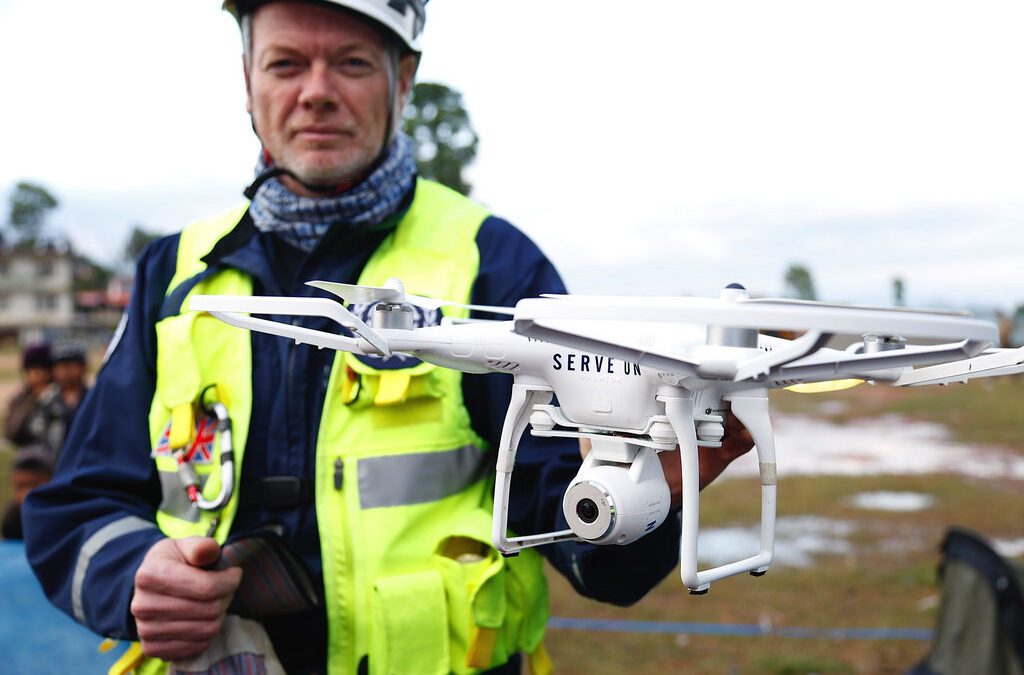
by Mary | Oct 7, 2015 | Construction, Design News, Interior Design, Project Management
Where do you learn about drones, BIM, Design-Assist? Turns out at the Fall COAA Workshop in Novi, Michigan.
Over 75 construction and design professionals gathered for a day of learning and networking in September 2015. Mary Witte, from r.o.i. Design attended.
The second session of the day was a presentation by three members of COAA, an owner, an architect and an contractor. This was a candid discussion of the process of building the team that determines the design, the cost and the timeline for buildings.
For r.o.i. Design, their comments about pre-qualifying team members through a RFQ (Request for Qualification Process) made a lot of sense and we understand how this step potentially saves the owner/project a considerable amount in fees. The presenters suggested that a large RFP (Request for Proposal) process could involve over 10,000 hours in professional time and still doesn’t guarantee best outcomes. They asked they question, “What can we take from the interviewing and bidding process to add value to the job?” Owners are living with a project long after the architect and contractor are gone, the decision who is on the team has a legacy implication. Start with clear understanding of what is important to the owner and let that drive the process of assembling the best team for the job. (Presenters: Leisa Williams-Swedberg, construction Administrator, Michigan State University, Nick Salowich, Principal, Science & Technology Studio Leader, Smith GroupJJR, Robert LaLonde, LLED AP, Vice President Clark Construction).

r.o.i. Design Pre-Design Rendering
Target Value Design (IPD-Integrated Product Delivery) was the topic of the third session.
This group of presenters, again from different disciplines, highlighted a process that, in r.o.i. Design’s view, was advocating for integration of the builders & makers into the budget and design process much earlier than the traditional model. (That model being: Concept, Design, Develop Design, Schematic Design, Construction Documentation 75%, 90% etc. ). This group asks the question, why does there need to be value engineering, why not value designing-real time analysis that is meaningful.
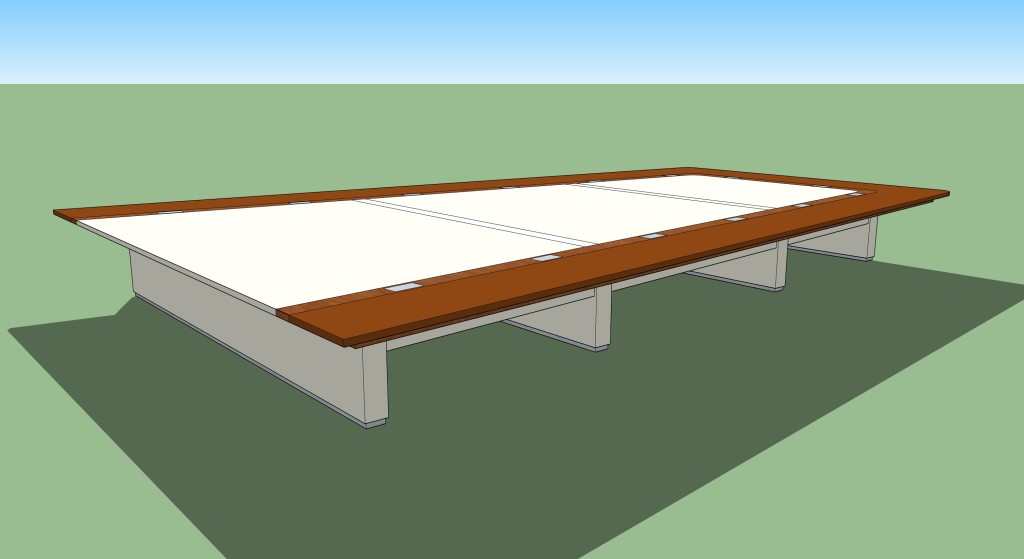
Whether designing a building or a table, consider bringing in the makers early in the process. Custom conference table designed by r.o.i. Design.
This discussion raised our awareness that designers have an opportunity to serve our clients by promoting a new process: Create 3-D illustrations to describe design intent to such detail that all related trades can begin to work on documents that build the design in a collaborative and integrated way. This also raised the concern on how designers would be compensated for their ideas, which began a discussion on the true nature of team. (Presenters: Anthony Bango, Vie President Project Planning, The Christman Company; Matt Cramer, President, De Cramer Inc; Kevin Kershbaum, HGA Architects)
r.o.i. Design understands that designers bring the greatest value to owners in two ways- creativity and management. Clearly describe the concept that meets the expectations and needs of the customer, and then manage the process. That doesn’t mean making every decision, drawing every schematic or trying to be the expert.
The final presentation felt like a continuation of the previous discussion, but with more “math”.
Design-Assist is a method of design-to construction that also engages contractors early in the process of planning. The presenters introduced the idea of all participants in a project to consider themselves “partners”. That would mean share the savings, share the profits, and be transparent with the opportunity for improvements. Any conflict over who owns ideas and solutions has no room in a design-assist process. This discussion looked at the opportunity to avoid “waste”: duplication of services, postponing decisions or making half decisions on half the information. This discussion gave us insight into an opportunity to develop respect and trust among team members. We are all conditioned and comfortable with our process, change is hard, but the future of construction has to be LEAN. (Presenters: Victor Sanvido, Senior Vice President, Southland Industries; George Karidis, PE, LEED AP BC+C, vice President, Corprate Engineer for Scince & Technology, SmithGroup JJR)
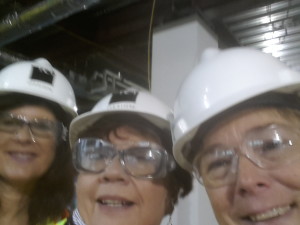
GVSU Marketplace Mary Jane Caster, Mary Witte, (Designers) and Carol Cool (GVSU Project Manager)
From Mary Witte: Through the day, I reflected on the r.o.i. Design “Budget, Brand and Beauty” story and was excited that our choice of practice is on track with the trends in our industry. Start with the owners values and interpretation of quality, develop a team, share all the information with the team, create process and structures that are inclusive and helpful, trust your team and ask them to trust you.
**
 r.o.i. Design has been working with Grand Valley State University since 2009 and through that work we discovered COAA. We have been impressed with the people and the quality of the information presented by and to the membership. It is a national organization with State Chapters. The Michigan Chapter presents two workshops a year, promotes their national training programs and encourages its members to attend the National Convention. We are proud members of COAA. www.coaa.org
r.o.i. Design has been working with Grand Valley State University since 2009 and through that work we discovered COAA. We have been impressed with the people and the quality of the information presented by and to the membership. It is a national organization with State Chapters. The Michigan Chapter presents two workshops a year, promotes their national training programs and encourages its members to attend the National Convention. We are proud members of COAA. www.coaa.org
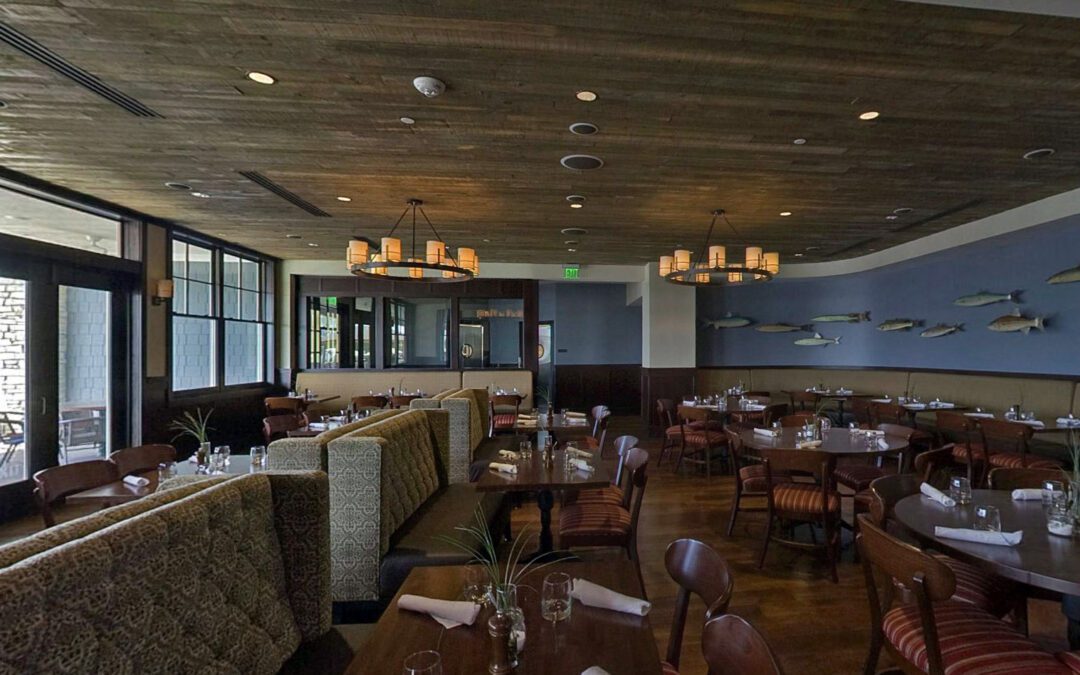
by Mary | Sep 6, 2015 | Construction, Hospitality Design, Interior Design, Restaurant Design, Retail Design
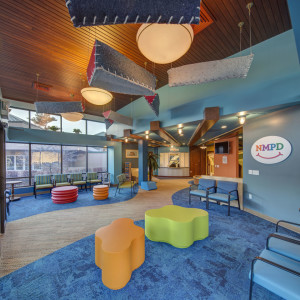
Northern Michigan Pediatric Dentistry. A design build team- r.o.i. Design was the interior designer.
Who is the design team?
The building architect, interior designer, site engineer, landscape architect, structural engineer, civil engineer, casegood designer, furniture designer, and art consultant all make up the design team.
Construction managers are dealing with a variety of team types:
One Stop Shopping
Large architect and engineering firms who offer “one stop shopping”, everything in one company, linear accountability. Convenient but not always transparent. When a design team has a bundle of work with a contractor, it is easier for the GM to negotiate changes since they are funneling a quantity of work to a firm.
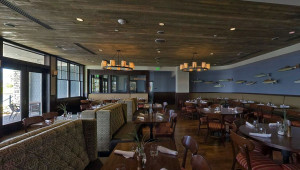
The Inn at Harbor Shores, r.o.i. Design was recommended by contractor as an industry specialist.
Industry Specialist
A key player (designer or architect) who offers unique experience in a construction type: charter schools, national retail chains, senior care, mid-scale hotels, higher education, specialty medical, etc. , who recommends a group of independents they or the contractor manages to fill out the roster of all the professional design requirements.
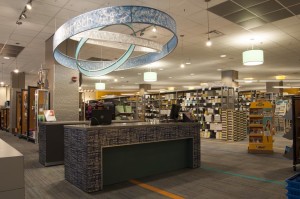
GVSU Laker Store, a customer directed design team. r.o.i. Design worked as planners and interior designers.
Customer Team
When there are pre-existing relationships that have to be managed and the contractor works with the customer to fill out the professional needs of the project with a variety of firms.
Design-Build
The “design-build” team is assembled by the contractor and the customer directs all design criteria to the contractor who then works with their choice of professionals to support planning, produce design, architecture, engineering and all it’s documentation.
So what is the ideal “design team”? It’s the one that works best for the project.
Experienced construction professionals understand that they can’t have just one process that will deliver the design on all their projects (unless the contractor only works with one building type). Experienced construction professionals know they have to have a variety of firms in their contact list and stay informed of changes in those firms, understanding their emerging strengths and successes on new projects.
##
r.o.i. Design works on several teams and team types. We understand the “R’s”: rates, relationships and relevance. We see successful design companies prosper when they can collaborate and adjust to changing criteria. We also see the importance of the construction manager who realizes the need for customers to be connected to the design process and their designers, and still be sure their budget and timeline are prioritized.

by Mary | Sep 6, 2015 | Construction, Design News, Designing Public Areas, Hospitality Design, Retail Design
Recently, r.o.i. Design was at a bid opening and after hearing the bids for Division 09, it was clear to all that something was “up”. We all are seeing a steady increase in the percentage of costs spent in finishes in projects.
r.o.i. Design has been able to balance budgets by applying specialty finishes with discretion in key areas and working with contractors on the design as a whole, before a project goes to bid. Managing customer expectations at the design phase is key in order to deliver the interior the customer requires.
Some of the areas to watch for creeping costs include:
Hard surface flooring
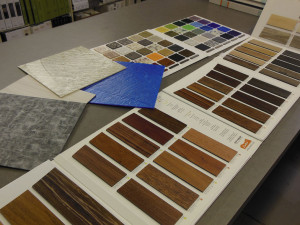
LVT is available in a wide selection of colors and patterns, including those that mimic wood and stone.
The old stand by – vinyl composite tile (VCT) – which is affordable at install, but adds cost
every year in maintenance, is loosing ground to other composites that don’t have that ongoing expense. There are VET (vinyl enhanced tiles) and LVT (luxury vinyl tiles) whose retail square foot costs are a minimum of $1 more than VCT.
A larger portion of the flooring in projects are receiving hard surfaces verses carpet.
The love for finished concrete isn’t necessarily a budget saver and it’s popularity has demanded more skilled trades in adapting concrete in order to be considered a finished floor.
Wall panels and specialty wall treatments
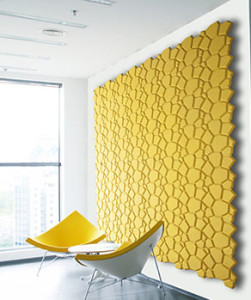
Molded cork wall coverings by Murrato
Wall covering manufacturers have been busy coming up with new materials and designs that are gaining interest. r.o.i. Design doesn’t believe we will ever see projects where 100% of the walls are covered with wall covering as was prevalent in the 90’s, but do see a percentage of the walls being given “special” treatment.
Custom wall covering and panel products are becoming more affordable allowing customers to create “branded” and proprietary looks to their interiors. Part of that customization means the finish category is fulfilling more of the signage requirements of a building.
Ceilings
 Changes in technology have advanced product design and improved product performance. But the first wave of those innovations come at a higher price. The cycle of new product introduction is more robust, and increased competition will start to impact costs on trendy finishes in a positive direction.
Changes in technology have advanced product design and improved product performance. But the first wave of those innovations come at a higher price. The cycle of new product introduction is more robust, and increased competition will start to impact costs on trendy finishes in a positive direction.
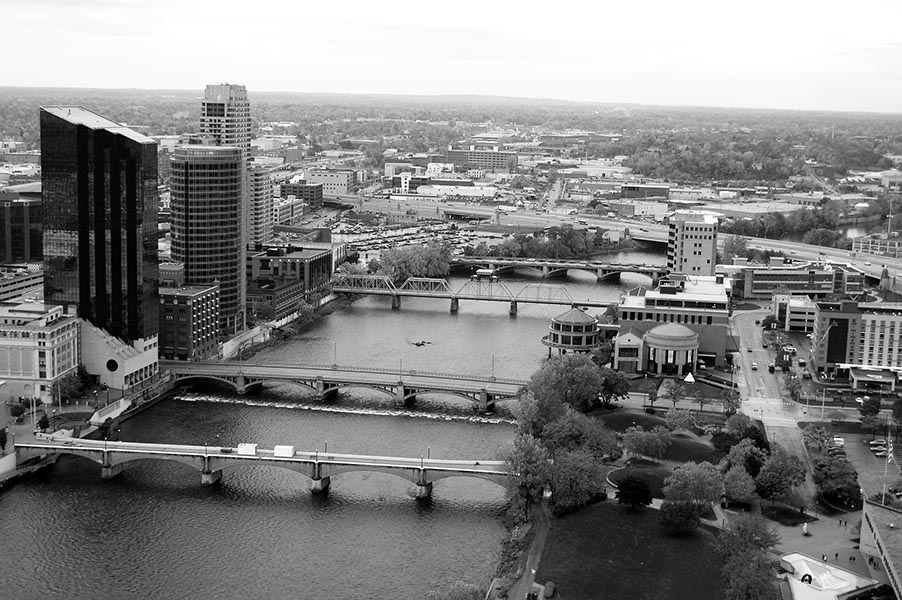
by Mary | Sep 6, 2015 | Construction

Downtown Grand Rapids Skyline
As reported by Michigan Construction News:
According to the U.S. Census Bureau, in July total construction put in place throughout the nation rose 0.7% from June’s revised estimate. July set an annual rate of $1,083.4 billion. The revised June rate was $1,075.9 billion.
Construction during the first seven months of this year has risen at an average rate of 9.3% above the rate set during the same period last year.
The Census Bureau is scheduled to release its August 2015 data on October 1st.
September 4, 2015
As reported by Mlive.com:
Apartment construction boomed in first half of 2015

Four new sorority houses are nearing completion in the second phase of construction at Grand Village Student Housing in Allendale near Grand Valley State University. The homes, photographed on Monday, July 13, will be complete in time for the fall semester. (Emily Rose Bennett | MLive.com)
GRAND RAPIDS, MI – Apartment construction boomed in West Michigan during the first half of 2015, according to a housing construction publication.
Building starts for single family homes were flat in West Michigan with the exception of Ottawa County, where the number of housing starts grew by 25 percent, according to Builder Track Reports, which follows the region’s construction trends.
In Kent County, building permits were issued for 662 apartment units, most of them in Grand Rapids. That’s more than twice the 324 units started in the first half of 2014.
July 16, 2015




![]() r.o.i. Design has been working with Grand Valley State University since 2009 and through that work we discovered COAA. We have been impressed with the people and the quality of the information presented by and to the membership. It is a national organization with State Chapters. The Michigan Chapter presents two workshops a year, promotes their national training programs and encourages its members to attend the National Convention. We are proud members of COAA. www.coaa.org
r.o.i. Design has been working with Grand Valley State University since 2009 and through that work we discovered COAA. We have been impressed with the people and the quality of the information presented by and to the membership. It is a national organization with State Chapters. The Michigan Chapter presents two workshops a year, promotes their national training programs and encourages its members to attend the National Convention. We are proud members of COAA. www.coaa.org









